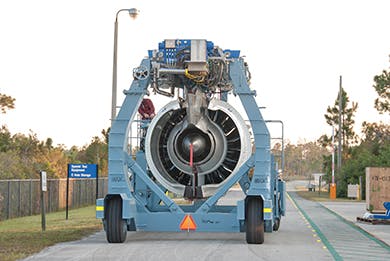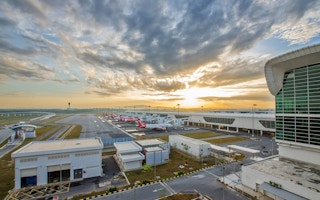Aviation produces around 3 percent of the world’s manmade carbon emissions (CO2), according to the United Nations. But despite their ubiquity, airplanes are actually more efficient and cleaner than most modes of transport.
Road vehicles such as cars and trucks account for one-fifth of emissions in the United States and the European Union, for example, and emit more gases per passenger than air travel.
However, air traffic is growing at a healthy five percent a year, driven by rising affluence among the growing middle class, particular in Asia. The region is currently one of the biggest aviation markets in the world and will lead in global air traffic for the next two decades, accounting for more than a third of all passenger traffic by 2034, according to Airbus’ Global Market Forecast for 2015-2034.
The challenge, therefore, is to accommodate this growth while maintaining or reducing the carbon emissions generated, especially amid rising global concerns on climate change.
Pratt & Whitney, one of the “big three” aero-engine manufacturers – along with General Electric and Rolls-Royce – views this challenge as a business opportunity, says Dr Alan Epstein, Pratt & Whitney’s vice president, technology and environment, in a recent interview.
“What’s good for the environment can be very good for business,” he says. “We realised more than 15 years ago that these investments we make in sustainability are very wise investments; we are able to stay ahead of regulations.”
Pratt & Whitney aims to be the sustainability leader in the aerospace sector, and is constantly “developing next-generation technologies to minimize our footprint and impact to the environment”, Epstein says.
“To this end, we differentiate ourselves through innovative design, product and manufacturing technologies with the environment in mind,” he adds.
Epstein joined Pratt & Whitney from the Massachusetts Institute of Technology (MIT) department of Aeronautics and Astronautics, where he focused on power and energy, aerospace propulsion, turbomachinery and noise, measurement and instrumentation, and microsystems. He holds numerous patents and has published more than 100 academic articles.
He has been MIT’s R. C. Maclaurin Professor of Aeronautics and Astronautics since 1996.
With its market-leading philosophy on sustainability and cutting edge innovation, the company has won over loyal repeat customers in the civil and military aviation space.
Its latest offering, the PurePower Geared Turbofan (GTF) engines – the result of 20 years of research and development and about a US$1 billion in investment – has also been a runaway bestseller; the company has sold 7,000 engines globally.

The PurePower Geared Turbofan. Image: Pratt & Whitney.
Qatar Airways will be the first airline to deploy the engines at the end of the year, installing 100 of them in 50 Airbus A320 planes.
After that, Bombardier’s CSeries planes will use them in early 2016, followed by other aircraft such as the Mitsubishi Regional Jet, the Embraer E-Jets, and the Irkut MC-21.
The next-generation jet engine
A revolution in aviation, the PurePower GTF engines can reduce a plane’s fuel consumption by 16 percent, noise emissions by 75 percent and regulated emissions (CO2) by 50 percent over existing jet engines, Epstein says.
“It represents a great leap forward in technological advancement,” he says. “The success of the GTF can be attributed to the fact that the industry considers the GTF engine as a game changer.”
Epstein is responsible for setting the direction and coordination of technology throughout Pratt & Whitney as it applies to product performance and environmental impact. He also leads the investment, development and incorporation of technologies that reduce the environmental impact of Pratt & Whitney’s products and services.
He has had a key role in the development of the PurePower engine.
“Yes, those investments do cost us but they are very wise investments,” Epstein says. “For the customer, it takes capital too to buy the new engines but you will reduce operating cost. In terms of fuel savings, it’s US$2 million per plane per year.”
“
“What’s good for the environment can be very good for business. We realised more than 15 years ago that these investments we make in sustainability are very wise investments; we are able to stay ahead of regulations.
Dr Alan Epstein, vice president, technology and environment, Pratt & Whitney
“These are the most efficient, quietest engines you can find.”
Pratt & Whitney is able to achieve the double-digit reductions in fuel consumption and noise and gas emissions by inserting a gear between the engine and the fan which allows the fan to spin more slowly while providing more thrust. The slow movement of the blades is what makes the engines so much quieter.
While the insertion of the gear requires both the engine and fan blades to be bigger, it also allows the engine to have 40 percent fewer parts than a conventional jet engine, making it much lighter.
With the fan blades also made of a low-cost aluminium-lithium alloy material, the entire plane ends up requiring less fuel to fly.
The reduction in engine noise allows airplane manufacturers such as Embraer, Boeing, Bombardier Airbus – and airlines – to meet new aviation noise regulations that will be in place across the European Union in June 2016.
These regulations call for the cutting of noise through the deployment of modern aircraft, land-use planning, quieter ground-control operations and restrictions on night-time flying.
While the GTF engines are truly ground-breaking and will airlines millions of dollars a year in fuel costs, prices have “stayed the same”, Epstein says.
“That’s the dynamics of the aviation industry,” he says. “We give the savings and innovation to airplane makers, they gave it away to the airlines, and the airlines give them to the travelling public.”
“And that has made air travel a lot cheaper.”
Singapore’s role in the GTF engines
With Asia becoming an increasingly important aviation market, Pratt & Whitney has plans to expand in the region.
Singapore has an important role to play in the expansion plans, Epstein says, and the company opened in February 2014 a new Component Solutions unit, a new repair and engineer facility at Seletar Aerospace Park.
This is part of Pratt & Whitney’s US$110 million investment in Seletar Aerospace Park, where the company is also building a new 180,000 square-foot facility to manufacture the PurePower engine hybrid aluminium fan blades and high pressure turbine disks.
The new facility, when it comes online next year, will support Pratt & Whitney’s global efforts to ramp up the production of the GTF engine to meet demand, Epstein says.
With the new engine yet to be in service in planes, Pratt & Whitney is already working on its next innovation, as well as playing an active role in shaping regulations around emissions.
“I’m currently working on the next engine that will give us another 10 percent in fuel efficiency,” Epstein says. “This research and scientific innovation will go on.”

















